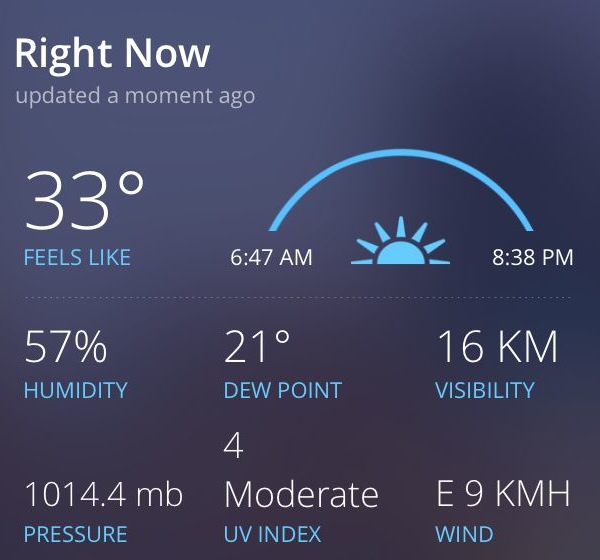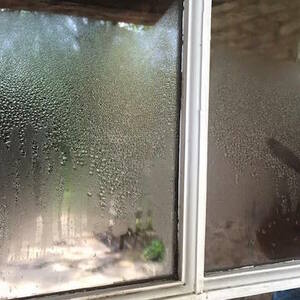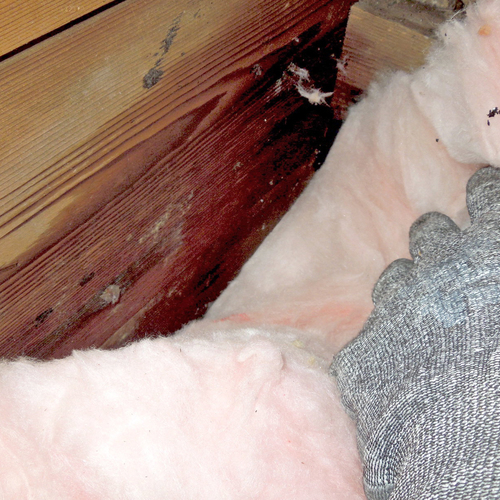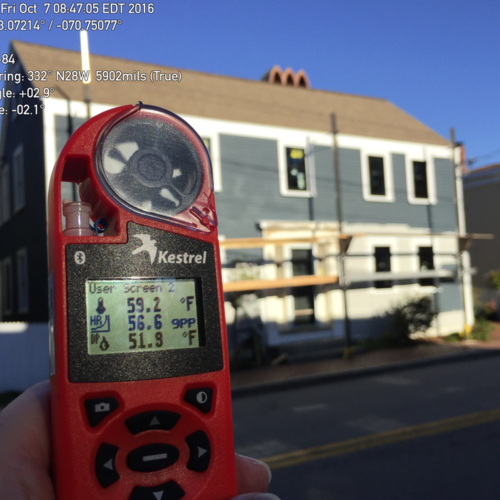
Image Credit: Energy Vanguard
There’s a problem with relative humidity. I hear it a lot when I talk to people about moisture problems. A client with high humidity in his home recently told me he didn’t understand how it could be more humid inside his home than it was outdoors. The indoor relative humidity (RH) was 60% while it was only 50% outdoors. Do you see the problem?
The problem with relative humidity
The name of this psychrometric quantity tells you the nature of the problem. It’s called relative humidity. That means you don’t really know how humid it is from that number alone. You also need to know the temperature.
Look at that screenshot from the weather app on my phone. Those are the conditions here in Atlanta this morning as I write this article. (Yes, I have it set for Celsius, not Fahrenheit. Don’t you?) The relative humidity is 57%. That doesn’t sound too bad. The air in my condo at the same time is 59%. Which is more humid?
Trick question! 59 is greater than 57, so the indoor air is more humid, yes, but only on a relative scale. The outdoor air in this case actually has more water vapor in it, though, because of the different temperatures. The outdoor air was 86°F at the time; the indoor air was at 74°F. The dew point temperatures were 70°F outdoors and 59°F indoors.
It’s not just homeowners who get confused about humidity. I hear pros who know some building science speak about humidity this way, too. “It’s been really humid here lately. The relative humidity is getting up into the 80s.” If they’d been talking about dew point, yes, it would have been really, really humid.
But Aspen, Colorado gets to 80% RH in the summer, too… in the mornings when the temperature is 50°F. The dew point is about 44°F then, which most consider to be pretty dry.
Why we need different humidity quantities
If relative humidity is so incomplete and confusing, why don’t we just drop it? Well, it’s still a useful quantity and does give us important information. Here’s a brief description of the three main quantities that describe humidity:
Relative Humidity – This quantity tells us how close the conditions are to saturation, when condensation of water vapor can occur. The interaction of porous materials with water vapor increases with increasing RH. The chance of growing mold increases with increasing RH, 70% usually given as the threshold to stay below.
Dew Point Temperature – This temperature scales with the amount of water vapor. As more water vapor enters a volume, the dew point goes up. If the air in your crawl space, for example, has a dew point of 75°F, you’re probably going to find condensation somewhere. Look at the water pipes, poorly insulated ducts, and uninsulated duct boots.
Wet Bulb Temperature – If dew point is the temperature of condensation, wet bulb is the temperature of evaporation. Same concept; different direction. This one’s important for cooling our bodies.
Once you get a handle on these three quantities, you’ll have a pretty good understanding of humidity. You’re then ready to enter the full study of psychrometrics.
Thinking clearly about humidity
If you take away one thing from this article, let it be this: Talking about relative humidity without also giving the temperature leads to confusion.
If you take away two things, let the second one be that even when you give the temperature along with the RH, you still may be wrong. Sometimes people tell me things like, “The temperature was 95°F and it was 90% relative humidity.” That would mean the dew point is 92°F. That’s possible but extremely rare, so I’m not likely to believe it. The record dew point is about 94°F. Even dew points in the 80s are rare.
When someone talks to me about relative humidity, I usually get my phone out and find the dew point with my handy-dandy psychrometrics app. If I’m interested in gauging comfort on a hot, muggy day, I look at the wet bulb temperature.
The problem with relative humidity is that, by itself, it doesn’t really tell you how humid it is.
Allison Bailes of Decatur, Georgia, is a speaker, writer, energy consultant, RESNET-certified trainer, and the author of the Energy Vanguard Blog. Check out his in-depth course, Mastering Building Science at Heatspring Learning Institute, and follow him on Twitter at @EnergyVanguard.
Weekly Newsletter
Get building science and energy efficiency advice, plus special offers, in your inbox.















4 Comments
Celsius
Greetings from the frozen north (It's 16° by the lake here) I am curious why you use Celsius. Temperature is the only thing that I think is actually better in Imperial than in Metric. It is a contentious issue: http://www.treehugger.com/culture/fahrenheit-better-temperature-scale-celsius-survey.html
Response to Lloyd Alter
I grew up with Fahrenheit, but I switched to Celsius 20 years ago, mostly because it's what most of the rest of the world uses. Getting degrees in physics brought me into the metric world, too. Yeah, Fahrenheit is better in that the degrees are smaller and you don't have to talk in tenths of halves of a degree. I converted mostly because I wanted to be familiar enough with the scale so I'd know both. Or maybe it's just because I like to change things up. I've been trying to become a left-hander for a while, too.
relative humidity more relevant than suggested?
Is it inaccurate to say that relative humidity is the most relevant metric regarding a number of important building issues, namely mold, wood movement, and effects on human mucous membranes?
Or perhaps I've missed the point of the article, in that it is simply pointing to the errors often made in talking about RH?
LLoyd
As a Canadian involved in the building scene you will have noticed that after decades of official metrification there are still areas that are resistant to moving from imperial. One of the main ones is dimensional lumber. You won't hear anyone call for a 2.38x385 beam. The metric increments simply aren't very useful.
Log in or create an account to post a comment.
Sign up Log in